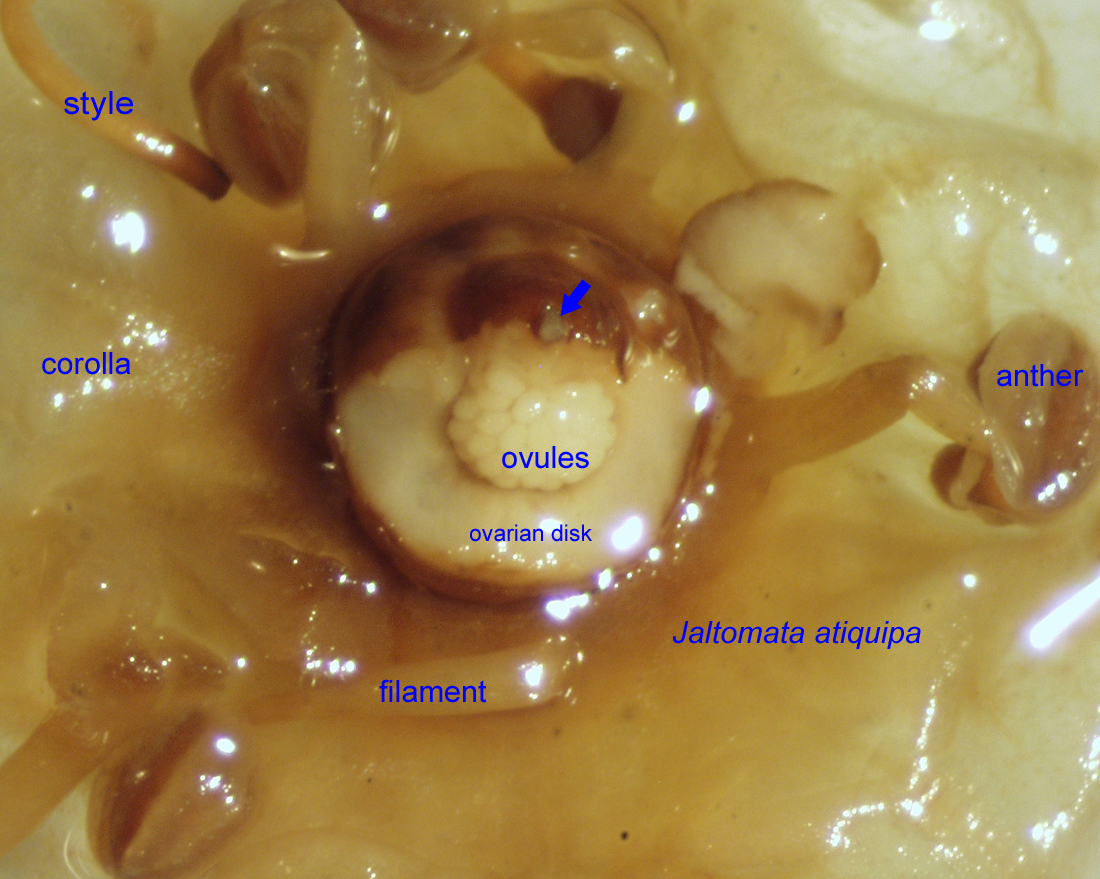| Character |
Description of Jaltomata atiquipa |
Figures on this web page |
Habit & Height |
Shrub to 1.5 m high |
2 |
Branches, young |
green, puberulent, terete (no longer terete after being pressed) |
|
older |
hollow, brown, glabrate with lenticels, to 1 cm diameter |
8 |
| Leaves, size |
the blade to 13 cm long X 11 cm wide |
11 |
| shape |
the blade ovate, the larger leaves basally truncate, sometimes basally oblique, the apex acute or subacute, sometimes acuminate, the margin subentire to toothed |
11 |
| arrangement and hairs |
alternate, sometimes geminate; young leaves puberulent becoming glabrate |
|
| petiole |
to 4.2 cm long |
11 |
Inflorescence |
axillary, to 7 (-8) flowered |
5, 7 |
peduncle |
green, to 21 mm long, terete, finely pubescent to glabrous |
5, 7 |
pedicel |
green, to 11 mm long, terete, finely pubescent to glabrous |
5, 7 |
| Calyx at flowering |
green and planar, 8 - 11 mm diameter, the lobes triangular, the margin ciliate |
3, 4 |
| at fruit maturity |
no data |
|
Corolla color |
white with green throat (10 green maculae in base) |
1, 2, 3, 4, 7, 13 |
shape and size |
crateriform, to 15 mm diameter when pressed |
1, 3, 4, 12, 13 |
lobes/lobules |
5-lobed |
1, 3, 4, 13 |
hairs |
the hairs of two types: nonglandular finger hairs (uniseriate) 0.8 mm long,
and stalked multicellular glands 75-85 micrometers long |
|
|
no |
13 |
| Stamen, length including anther |
4 mm |
1 |
| filaments |
whitish, glabrous except for the base where the hairs are 0.21 mm long |
1, 6 |
| anther color & length |
cream-colored prior to dehiscence, 1.1 - 1.4 mm long, emucronate |
1, 6,12 |
| anthers of a flower open simultaneously? |
to answer this question (January 2011) all photos taken (when the type collection was made) were carefully observed: all flowers but one show either dehisced anthers are undehisced anthers suggesting that for the most part the anthers of a flower do dehisced simultaneously or nearly simultaneously. A few photos do show some differences in timing of dehiscence among the anthers of a flower. |
1 |
| pollen quantity |
per androecium: range 58,250 - 99,500, mean 69,950
(n = 5 flowers of the type collection) |
counts by Alison Cameron
Jan 2011 |
| pollen grain size |
diameter: range 25 - 30 micrometers, mean 28.67 micrometers
(24 grains, type collection stored in 70% ethanol until Feb 2011 when grains were stained in cotton blue in lactophenol and measued by T. M. in polar view)
|
|
Gynoecium |
glabrous except for stigma papillae |
6 |
Stigma |
green, capitate with a shallow medial groove, exserted beyond the dehisced anthers |
1, 13 |
Style |
whitish, 6 mm long |
3, 4, 6 |
Ovary |
green; the ovarian (nectary) disk orangish and fairly thick, occupying about 60% of the height of the ovary |
6 |
Ovules per ovary |
81 - 94 (four flowers, mean 88.75) |
6 |
| Nectar |
red/orange nectar not present |
1, 3, 4, 7, 12, 13 |
| Herkogamy |
Yes, the stigma is exserted a few mm beyond the dehisced anthers |
1, 4 |
| Protogyny |
To answer this question all photos taken (when the type collection was made) were carefully observed: there are a few open flowers that show undehisced anthers and are thurs showing a pistillate phase of uncertain duration. There is no way of knowing, with the information at hand, if the duration of protogyny is say one hour or one full day, and there is no way of knowing if all flowers are pistillate before becoming functionally hermaphroditic (comments of January 2011). |
only figure 12, all other figures show functionally hermaphroditic flowers |
Fruit color (at maturity) and size |
not seen, most likely orange; no data for mature fruit size but probably about a cm in diameter |
|
Infructescence |
no data |
|
Seeds per fruit |
no data |
|
Seed Size |
no data |
|
Chromosome number |
no data |
|
Growability in Connecticut, USA |
no attempt to grow has been made |
|
How long does it take from flower to ripe fruit? |
no data |
|
Self-Compatible? |
no data |
|
Seed Germination |
no data |
|

JaltomatawAug2011.jpg)